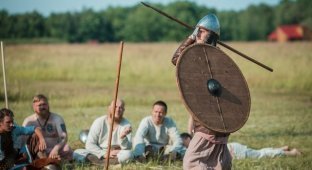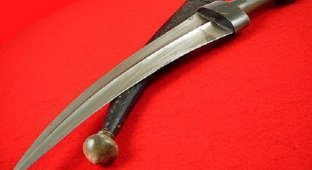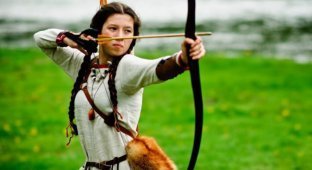I present to you a small selection of armor and weapons. I warn the lazy people at once there are not just a lot of letters, but a lot. For aesthetes, I want to add - it has not been read or verified. So you are not welcome here.

Firearms are not only a natural, but also a necessary element of the medieval setting. It was not by chance that warriors with “fiery shooting” appeared in knightly armies. The spread of heavy armor naturally led to an increase in interest in weapons capable of piercing them.

The secret of gunpowder (if, of course, we can talk about a secret here) lies in the special properties of saltpeter. Namely, the ability of this substance to release oxygen when heated. If saltpeter is mixed with any fuel and set on fire, a “chain reaction” will begin. The oxygen released by saltpeter will increase the intensity of combustion, and the hotter the flame flares up, the more oxygen will be released. People learned to use saltpeter to increase the effectiveness of incendiary mixtures back in the 1st millennium BC. It was just not easy to find her. In countries with hot and very humid climates, white, snow-like crystals could sometimes be found on the site of old fire pits. But in Europe, saltpeter was found only in stinking sewer tunnels or in bat-inhabited caves. Although in China, the discovery of a method for “growing” saltpeter in special pits or shafts made of earth and manure dates back to the 7th century. This technology made it possible to regularly use flamethrowers and rockets, and later firearms.

In 1320, the German monk Berthold Schwartz “invented gunpowder.” Now it is impossible to establish how many people in different countries invented gunpowder before Schwartz, but we can say with confidence that after him no one succeeded! And the “classic” composition of gunpowder became known to Europeans even before its birth. But in his treatise “On the Benefits of Gunpowder,” he gave clear practical recommendations for the manufacture and use of gunpowder and cannons. It was thanks to his work that during the second half of the 14th century the art of fire shooting began to rapidly spread in Europe. So this monk most likely did not “invent gunpowder,” but laid the foundation for its practical use in Europe.

In the “classic” version, black gunpowder included 60% saltpeter and 20% each of sulfur and charcoal. Charcoal could successfully be replaced with ground brown coal (brown powder), cotton wool or dried sawdust (white gunpowder). There was even “blue” gunpowder, in which coal was replaced with cornflower flowers. Sulfur was also not always present in gunpowder. For cannons, the charge in which was ignited not by sparks, but by a torch or a hot rod, gunpowder could be made consisting only of saltpeter and brown coal.
In the Middle Ages, gunpowder was prepared in the form of powder, or “pulp.” When loading the weapon, the “pulp” stuck to the inner surface of the barrel and had to be nailed to the fuse with a ramrod for a long time. In the 15th century, to speed up the loading of guns, lumps or small “pancakes” began to be sculpted from powder pulp. And at the beginning of the 16th century, “pearl” gunpowder, consisting of small hard grains, was invented.

The grains no longer stuck to the walls, but rolled down to the breech of the barrel under their own weight. In addition, graining made it possible to increase the power of gunpowder almost twice, and the duration of gunpowder storage by 20 times. Gunpowder in the form of pulp easily absorbed atmospheric moisture and deteriorated irreversibly within 3 years.
However, due to the high cost of “pearl” gunpowder, the pulp often continued to be used for loading guns until the mid-17th century. The Cossacks used homemade gunpowder in the 18th century.

Although, to be honest, the credit for inventing firearms definitely belongs to the Chinese. The ability of gunpowder to throw projectiles from metal barrels is reported in Chinese chronicles of the 7th century.
The simplest hand-held firearm, the hand grip (Russian name), appeared in China already in the middle of the 12th century. The most ancient samopals of the Spanish Moors date back to the same period. And from the beginning of the 14th century, “fire-fighting pipes” began to be fired in Europe. Hand cranks appear in the chronicles under many names. The Chinese called such a weapon pao, the Moors - modfa or carab (hence the word "carbine"), and the Europeans - hand bombard, handcanona, sklopetta, petrinal or culverina.

The handle weighed from 4 to 6 kilograms and was a blank of soft iron, copper or bronze drilled from the inside. The barrel length ranged from 25 to 40 centimeters, the caliber could be 30 millimeters or more. The projectile was usually a round lead bullet. In Europe, however, until the beginning of the 15th century, lead was rare, and self-propelled guns were often loaded with small stones.

As a rule, hand grips were mounted on a shaft, the end of which was clamped under the armpit or inserted into the current of the cuirass. Less commonly, the butt could cover the shooter's shoulder from above. Such tricks had to be resorted to because it was impossible to rest the butt of the handbrake on the shoulder: after all, the shooter could support the weapon with only one hand, and with the other he brought the fire to the fuse. The charge was ignited with a “scorching candle” - a wooden stick soaked in saltpeter. The stick was pressed against the ignition hole and turned, rolling in the fingers. Sparks and pieces of smoldering wood fell inside the barrel and sooner or later ignited the gunpowder.
The extremely low accuracy of the weapon allowed effective shooting only from a point-blank range. And the shot itself occurred with a long and unpredictable delay. Only the destructive power of this weapon aroused respect. Although a bullet made of stone or soft lead at that time was still inferior to a crossbow bolt in penetrating power, a 30-mm ball fired at point-blank range left such a hole that it was worth looking at. Or he would tear off the victim’s head.

It was a hole, but it was still necessary to get in. And the depressingly low accuracy of the hand grip did not allow one to expect that the shot would have any consequences other than fire and noise. It may seem strange, but it was enough! Hand bombards were valued precisely for the roar, flash and cloud of sulfur-smelling smoke that accompanied the shot. Loading them with a bullet was not always considered advisable. The knight's horse was not afraid of fire. But if he was blinded by a flash, deafened by a roar, and even insulted by the stench of burning sulfur, he still lost his courage and threw off the rider. Against horses not accustomed to shots and explosions, this method worked flawlessly. But the knights were not able to introduce their horses to gunpowder right away. In the 14th century, “smoke powder” was an expensive and rare commodity in Europe. And most importantly, at first he aroused fear not only among the horses, but also among the riders. The smell of “hellish brimstone” made superstitious people tremble. However, people in Europe quickly got used to the smell. But the loudness of the shot was listed among the advantages of firearms until the 17th century.

At the beginning of the 15th century, self-propelled guns were still too primitive to seriously compete with bows and crossbows. But fire tubes quickly improved. Already in the 30s of the 15th century, the pilot hole was moved to the side, and a shelf for seed powder began to be welded next to it. This gunpowder, upon contact with fire, flared up instantly, and after just a split second, the hot gases ignited the charge in the barrel. The gun began to fire quickly and reliably, and most importantly, it became possible to mechanize the process of lowering the wick. In the second half of the 15th century, fire tubes acquired a lock and butt borrowed from the crossbow. At the same time, metalworking technologies were also improved. The trunks were now made only from the purest and softest iron. This made it possible to minimize the likelihood of explosion when fired. On the other hand, the development of deep drilling techniques made it possible to make gun barrels lighter and longer.

This is how the arquebus (in Rus' squeaker) appeared - a weapon with a caliber of 13-18 millimeters, weighing 3-4 kilograms and a barrel length of 50-70 centimeters. An ordinary 16-mm arquebus ejected a 20-gram bullet with an initial speed of about 300 meters per second. Such bullets could no longer rip people’s heads off, but from 30 meters they would make holes in steel armor. Firing accuracy increased, but was still insufficient. An arquebusier could hit a person only from 20-25 meters, and at 120 meters, shooting even at such a target as a pikeman battle turned into a waste of ammunition. However, light guns retained approximately the same characteristics until the mid-19th century—only the lock changed. And in our time, shooting a bullet from a smoothbore gun is effective no further than 50 meters.
Loading an arquebus was a rather complicated procedure. To begin with, the shooter disconnected the smoldering wick and put it in a metal case attached to his belt or hat with slits for air access. Then he uncorked one of the several wooden or tin cartridges he had - “loaders”, or “gazyrs” - and poured a pre-measured amount of gunpowder from it into the barrel. Then he nailed the gunpowder to the treasury with a ramrod and stuffed a felt wad into the barrel to prevent gunpowder from spilling out. Then - a bullet and another wad, this time to hold the bullet. Finally, from the horn or from another charge, the shooter poured some gunpowder onto the shelf, slammed the lid of the shelf and reattached the wick to the trigger lips. It took an experienced warrior about 2 minutes to do everything.


In the second half of the 15th century, arquebusiers took a strong place in European armies and began to quickly push out competitors - archers and crossbowmen. But how could this happen? After all, the combat qualities of the guns still left much to be desired. Competitions between arquebusiers and crossbowmen led to a stunning result - formally, the guns turned out to be worse in all respects! The penetrating power of the bolt and the bullet was approximately equal, but the crossbowman shot 4-8 times more often and at the same time did not miss a tall target even from 150 meters!
The problem with the crossbow was that its advantages were of little practical value. Bolts and arrows flew “in the eye” in competitions when the target was motionless and the distance to it was known in advance. In a real situation, the arquebusier, who did not have to take into account the wind, the movement of the target and the distance to it, had the best chance of hitting. In addition, bullets did not have the habit of getting stuck in shields and sliding off armor; they could not be dodged. The rate of fire was not of great practical importance: both the arquebusier and the crossbowman only had time to fire once at the attacking cavalry. The spread of arquebuses was restrained only by their high cost at that time. Even in 1537, Hetman Tarnovsky complained that “there are few arquebuses in the Polish army, only vile hand cranks.”

It is a fairly common misconception that the advent of firearms marked the end of the romantic “age of chivalry.” In fact, arming 5-10% of soldiers with arquebuses did not lead to a noticeable change in the tactics of European armies. At the beginning of the 16th century, bows, crossbows, darts and slings were still widely used. Heavy knightly armor continued to be improved, and the main means of counteracting cavalry remained the pike. The Middle Ages continued as if nothing had happened. And knightly armor reached perfection after the spread of arquebuses.

The romantic era of the Middle Ages was shaken only in 1525, when, at the Battle of Pavia, the Spaniards first used a new type of matchlock gun - muskets. Which primarily differed from the arquebus in size. Weighing 7-9 kilograms, the musket had a caliber of 22-23 millimeters and a barrel about one and a half meters long. Only in Spain, the most technically developed country in Europe at that time, could a durable and relatively light steel barrel of such length and caliber be made.
Naturally, such a bulky and massive gun could only be fired from a support, and two people had to operate it. But a bullet weighing 50-60 grams flew out of the musket at a speed of over 500 meters per second. The musket hit with such force that the shooter had to wear a cuirass or a leather pad on his shoulder to prevent the recoil from splitting his collarbone.

The long barrel provided the musket with relatively good accuracy for a smooth gun. The musketeer hit a person not from 20-25, but from 30-35 meters. But of much greater importance was the increase in the effective salvo firing range to 200-240 meters. At this entire distance, the bullets retained the ability to hit knightly horses and pierce the iron armor of pikemen. The musket combined the capabilities of the arquebus and pike, and became the first weapon in history that gave the shooter the opportunity to repel the onslaught of cavalry in open terrain. Musketeers did not have to run away from cavalry during a battle, therefore, unlike arquebusiers, they made extensive use of armor. Due to the heavy weight of their weapons, musketeers, like crossbowmen, preferred to travel on horseback.
Throughout the 16th century, there remained few musketeers in European armies. Musketeer companies (detachments of 100-200 people) were considered the elite of the infantry and were formed from nobles. This was partly due to the high cost of weapons (as a rule, a musketeer’s equipment also included a riding horse). But even more important were the high requirements for durability. When the cavalry rushed to attack, the musketeers had to repel it or die.

Smoldering wicks, of course, caused a lot of inconvenience for the shooters. However, the simplicity and reliability of the matchlock forced the infantry to put up with its shortcomings until the end of the 17th century. Another thing is the cavalry. The rider needed a weapon that was comfortable, always ready to fire and suitable for holding with one hand.
The first attempts to create a castle in which fire would be produced using iron flint and “flint” (that is, a piece of sulfur pyrite or pyrite) were made back in the 15th century. Since the second half of the 15th century, “grating locks” have been known, which were ordinary household flints installed above a shelf. With one hand the shooter aimed the weapon, and with the other he struck the flint with a file. Due to the obvious impracticality, grater locks did not become widespread.

The wheel castle, which appeared at the turn of the 15th and 16th centuries, became much more popular in Europe, the diagram of which was preserved in the manuscripts of Leonardo da Vinci. The ribbed flint was given the shape of a gear. The spring of the mechanism was cocked with the key supplied to the lock. When the trigger was pressed, the wheel began to rotate, striking sparks from the flint.
The wheel lock was very reminiscent of a watch and was not inferior to a watch in complexity. The capricious mechanism was very sensitive to clogging with gunpowder fumes and flint fragments. After 20-30 shots it stopped firing. The shooter could not disassemble it and clean it on his own.
Since the advantages of the wheel lock were of the greatest value for cavalry, weapons equipped with it were usually made convenient for the rider - one-handed. Starting from the 30s of the 16th century, in Europe, shortened wheeled arquebuses without a butt came into service. Since the production of such weapons began in the Italian city of Pistol, one-handed arquebuses began to be called pistols. However, by the end of the century, pistols were also produced at the Moscow Armory.

European military pistols of the 16th and 17th centuries were very bulky designs. The barrel had a caliber of 14-16 millimeters and a length of at least 30 centimeters. The total length of the pistol exceeded half a meter, and the weight could reach 2 kilograms. However, the pistols struck very inaccurately and weakly. The range of an aimed shot did not exceed several meters, and even bullets fired at point-blank range sometimes bounced off cuirasses and helmets.

In the 16th century, pistols were often combined with edged weapons, such as a club head (“apple”) or even an ax blade. In addition to their large dimensions, pistols of the early period were characterized by rich decoration and intricate design. Pistols of the 16th and early 17th centuries were often made with multiple barrels. Including one with a rotating block of 3-4 barrels, like a revolver! All this was very interesting, very progressive... But in practice it very often did not work.
The wheel lock itself cost so much money that decorating the pistol with gold and pearls no longer significantly affected its price. In the 16th century, wheeled weapons were affordable only by very rich people and had more prestige than combat value.

Which led to the emergence of a new type of castle - a flint castle. In which sparks were struck when the silicon, fixed in the lock, hit the flint. Placed so that sparks would fall on the shelf with gunpowder poured on it. And it was with the advent of this type of lock that firearms became widespread. And it was practically not improved for three centuries. Until the middle of the 19th century, capsule locks replaced flintlocks.

From the mid-14th century, special “fortress” guns began to be used in the defense of fortresses. In Russia they were called “gakovnitsy” or “zatina squeakers”. Already from the name it is clear that this weapon had a hook (hook), which clung to the outer surface of the wall (tyna). When fired, the hook absorbed the recoil. And there was something to accept - the caliber of serf rifles reached 30 millimeters. At the same time, the weight of the hooks ranged from 7 to 30 kilograms, and the length could reach 330 centimeters! Giant sizes, however, were primarily characteristic of Turkish and Chinese serf rifles of the 16th and 17th centuries. In Asia, this weapon was given the greatest importance.
They shot from the racks mainly with “lots” - chopped lead. Gunshot was not dangerous for horses and men-at-arms, but it hit a wide area. When firing at a long distance, one could count on at least one of the buckshots to hit the target. Therefore, depending on the length of the barrel, effective fire could be fired at a distance of 70-200 meters. For the convenience of loading buckshot, back in the 16th century, the barrels of serf guns sometimes began to be equipped with a bell.

Loading the huge fortress guns, of course, was difficult and time-consuming. But, unlike guns, tacks were transportable. In the event of an assault, many trunks could be collected in the threatened area. The lightest fortress arquebuses could also be used in field battles. In this case, they fired from them in the same way as from muskets - from a support.
As a result, it was only from the 16th century that the development of firearms began to determine the tactics of sea and land battles. The balance between close and ranged combat began to shift in favor of the latter. The importance of protective equipment began to decline, and the role of field fortifications began to increase.


























